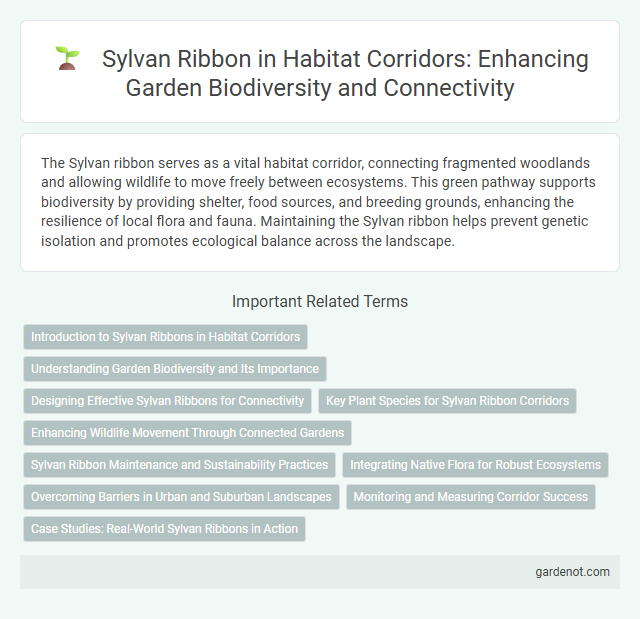The Sylvan ribbon serves as a vital habitat corridor, connecting fragmented woodlands and allowing wildlife to move freely between ecosystems. This green pathway supports biodiversity by providing shelter, food sources, and breeding grounds, enhancing the resilience of local flora and fauna. Maintaining the Sylvan ribbon helps prevent genetic isolation and promotes ecological balance across the landscape.
Introduction to Sylvan Ribbons in Habitat Corridors
Sylvan ribbons serve as essential habitat corridors that connect fragmented ecosystems, enabling wildlife movement and genetic exchange. These linear strips of native vegetation enhance biodiversity by providing shelter, food, and migration pathways for various species. Integrating sylvan ribbons into landscape planning restores ecological balance and supports long-term conservation goals.
Understanding Garden Biodiversity and Its Importance
Sylvan Ribbon serves as a vital habitat corridor that supports diverse species by connecting fragmented garden ecosystems, promoting genetic exchange and resilience. The preservation of such corridors enhances pollinator activity, beneficial insect populations, and native plant growth, directly contributing to overall garden biodiversity. Understanding Sylvan Ribbon's role in sustaining these interactions highlights its critical importance in maintaining ecological balance and fostering sustainable urban and suburban gardens.
Designing Effective Sylvan Ribbons for Connectivity
Designing effective Sylvan ribbons for habitat connectivity requires integrating native vegetation corridors that support wildlife movement and genetic exchange between isolated populations. Incorporating multi-layered plant species enhances habitat complexity, fostering biodiversity and resilience against environmental changes. Strategic placement of Sylvan ribbons within fragmented landscapes maximizes ecological connectivity, improving ecosystem health and species survival rates.
Key Plant Species for Sylvan Ribbon Corridors
Key plant species for sylvan ribbon corridors include native oaks (Quercus spp.), sugar maples (Acer saccharum), and American beeches (Fagus grandifolia), which provide essential habitat and food sources for wildlife. Understory plants such as spicebush (Lindera benzoin) and mayapple (Podophyllum peltatum) contribute to the structural diversity and support pollinators. These species collectively enhance corridor connectivity by promoting biodiversity and ecological resilience within sylvan ribbon habitats.
Enhancing Wildlife Movement Through Connected Gardens
Sylvan Ribbon creates continuous green pathways that enhance wildlife movement by linking fragmented habitats through connected gardens. These corridors support biodiversity by allowing species to migrate, forage, and reproduce safely across urban and suburban areas. Incorporating native plants and minimizing barriers within Sylvan Ribbon gardens fosters ecological resilience and promotes healthier wildlife populations.
Sylvan Ribbon Maintenance and Sustainability Practices
Sylvan Ribbon Habitat Corridor employs sustainable maintenance practices that prioritize native vegetation restoration and invasive species control to enhance biodiversity. Regular ecological monitoring guides adaptive management strategies, ensuring long-term habitat connectivity and resilience. These efforts reduce soil erosion and support pollinator populations, fostering a healthy ecosystem within the corridor.
Integrating Native Flora for Robust Ecosystems
The Sylvan Ribbon habitat corridor prioritizes integrating native flora such as oak, dogwood, and wildflowers to establish resilient ecosystems that support diverse wildlife. Native plant species enhance soil health, improve water retention, and provide critical food and shelter for pollinators and other fauna. Restoration efforts focus on reintroducing indigenous vegetation to strengthen ecological connectivity and promote long-term environmental stability.
Overcoming Barriers in Urban and Suburban Landscapes
The Sylvan Ribbon serves as a vital habitat corridor designed to overcome barriers in urban and suburban landscapes by reconnecting fragmented ecosystems and facilitating wildlife movement. It incorporates green bridges, underpasses, and native vegetation to ensure safe passage for diverse species across roads and developed areas. This strategic connectivity enhances biodiversity, supports ecological resilience, and promotes sustainable urban planning.
Monitoring and Measuring Corridor Success
The Sylvan Ribbon habitat corridor employs advanced GPS tracking and motion-sensor cameras to monitor wildlife movement and assess connectivity effectiveness. Data on species diversity and migration frequency is continuously collected to measure ecological impacts and habitat utilization. Regular analysis of these metrics ensures adaptive management strategies for maintaining corridor success and biodiversity preservation.
Case Studies: Real-World Sylvan Ribbons in Action
Sylvan ribbons, natural habitat corridors densely lined with native trees and shrubs, play a critical role in supporting biodiversity by connecting fragmented ecosystems. Case studies from Australia's eucalyptus sylvan ribbons demonstrate their effectiveness in facilitating wildlife movement and genetic exchange among isolated populations, leading to increased species resilience. Urban implementations in Canada further reveal how sylvan ribbons improve ecological connectivity, reduce habitat loss, and enhance ecosystem services such as air purification and climate regulation.
Sylvan ribbon Infographic

 gardenot.com
gardenot.com